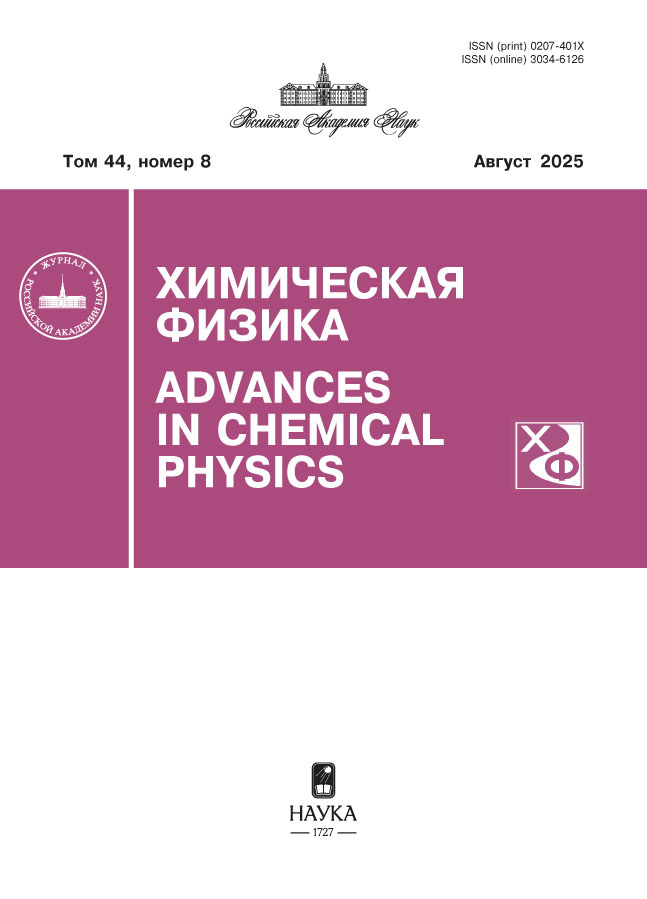The structure of tetranuclear zirconium pivalate ZR4O2 [(CH3)3CCO2]12 according to X-ray diffraction analysis and quantum chemical calculations
- Authors: Makhaev V.D.1, Petrova L.A.1, Shilov G.V.1, Bozhenko K.V.1, Utenyshev A.N.1, Aldoshin S.M.1
-
Affiliations:
- Federal Research Center of Chemical Physics and Medicinal Chemistry of the Russian Academy of Sciences
- Issue: Vol 43, No 4 (2024)
- Pages: 8-17
- Section: СТРОЕНИЕ ХИМИЧЕСКИХ СОЕДИНЕНИЙ, КВАНТОВАЯ ХИМИЯ, СПЕКТРОСКОПИЯ
- URL: https://cijournal.ru/0207-401X/article/view/674956
- DOI: https://doi.org/10.31857/S0207401X24040023
- EDN: https://elibrary.ru/VFKCYU
- ID: 674956
Cite item
Abstract
The crystal and molecular structure of a polynuclear pivalate complex obtained by the interaction of ZrCl4 with pivalic acid was determined by X-ray diffraction analysis. The compound C71H124O28Zr4 (compound 1) crystallizes in the monoclinic crystal system. The crystal structure was refined in the nonstandard space group I2. The asymmetric part of the structure includes three Zr atoms, six pivalate ligands, a bridging µ3-O oxygen atom, as well as disordered crystallization molecules of pivalic acid with an occupancy of 50% and benzene with an occupancy of 50%. The zirconium complex molecule is a tetranuclear cluster that contains three types of Zr atoms that differ in ligand environment. Comparison of the results of quantum chemical calculations of the model reaction ZrCl4 with acetic acid with the literature data on reactions of ZrCl4 with aliphatic acids have shown the possibility of the formation of both mononuclear Zr(RCO2)4 and polynuclear clusters in this reaction, which is a new route for obtaining polynuclear zirconium clusters. The structure of the clusters formed depends on the steric properties of carboxylate ligands.
Full Text
About the authors
V. D. Makhaev
Federal Research Center of Chemical Physics and Medicinal Chemistry of the Russian Academy of Sciences
Author for correspondence.
Email: vim@icp.ac.ru
Russian Federation, Chernogolovka
L. A. Petrova
Federal Research Center of Chemical Physics and Medicinal Chemistry of the Russian Academy of Sciences
Email: vim@icp.ac.ru
Russian Federation, Chernogolovka
G. V. Shilov
Federal Research Center of Chemical Physics and Medicinal Chemistry of the Russian Academy of Sciences
Email: vim@icp.ac.ru
Russian Federation, Chernogolovka
K. V. Bozhenko
Federal Research Center of Chemical Physics and Medicinal Chemistry of the Russian Academy of Sciences
Email: vim@icp.ac.ru
Russian Federation, Chernogolovka
A. N. Utenyshev
Federal Research Center of Chemical Physics and Medicinal Chemistry of the Russian Academy of Sciences
Email: vim@icp.ac.ru
Russian Federation, Chernogolovka
S. M. Aldoshin
Federal Research Center of Chemical Physics and Medicinal Chemistry of the Russian Academy of Sciences
Email: vim@icp.ac.ru
Russian Federation, Chernogolovka
References
- R. C. Mehrotra, R. Bohra, Metal Carboxylates. London: Academic Press, (1983).
- J. Ludvig, D. Schwarz, Inorg. Chem. 9, 607 (1970). https://doi.org/10.1021/ic50085a034
- G. Kickelbick, U. Schubert, Chem. Ber. Recueil. 130, 473 (1997). https://doi.org/10.1002/cber.19971300406
- P. Piszczek, A. Radtke, A. Grodzicki, A. Wojtczak, J. Chojnacki, Polyhedron. 26, 679 (2007). https://doi.org/10.1016/j.poly.2006.08.025
- J. H. Cavka, S. Jakobsen, U. Olsbye, et al., J. Am. Chem. Soc. 130, 13850 (2008). https://doi.org/10.1021/ja8057953
- Z. Chen, S.L. Hanna, L.R. Redfern, et al., Coord. Chem. Rev. 386, 32 (2019). https://doi.org/10.1016/j.ccr.2019.01.017
- T. Frot, S. Cochet, G. Laurent, et al., Eur. J. Inorg. Chem. 36, 5650 (2010). https://doi.org/10.1002/ejic.201000807
- E. Comyns. Encyclopedic Dictionary of Named Processes in Chemical Technology. Fourth Edition. Boca Raton, London, New York: CRC Press Inc. (2014).
- K. Mishra. Smart Ceramics: Preparation, Properties, and Applications. Singapore: Jenny Stanford Publishing, (2018) ISBN 1351671642.
- T. Sugimoto. Monodispersed Particles. 2nd Edition. Amsterdam: Elsevier (2019). ISBN 9780444627490
- T. J. Boyle, L. A. M. Ottley, M. A. Rodriguez. Polyhedron. 24, 1727 (2005). https://doi.org/10.1016/j.poly.2005.05.005
- J. J. Schneider, R. C. Hoffmann, A. Issanin, S. Dilfer. Mater. Sci. Eng.: B. 176, 965 (2011). https://doi.org/10.1016/j.mseb.2011.05.024
- Xue Wang, Meng Sun. Int. J. Electrochem. Sci. 16, 210530 (2021). https://doi.org/10.20964/2021.05.42
- M. Salehipour, S. Rezaei, M. Rezaei, M. Yazdani, M. Mogharabi-Manzari, J. Inorg. Organomet. Polym. Mater. 31, 4443 (2021). https://doi.org/10.1007/s10904-021-02118-7
- V. D. Makhaev, L. A. Petrova. Russ. J. Inorg. Chem. 56, 304 (2011). https://doi.org/10.1134/S0036023611020185
- V. D. Makhaev, L. A. Petrova. Russ. J. Gen. Chem. 88, 1430 (2018). https://doi.org/10.1134/S1070363218070137
- G. M. Sheldrick. Acta Cryst., C71, 3 (2015). https://doi.org/10.1107/S2053229614024218
- Licence to Use Agreement: Gaussian, Inc., Wallingford, CT 06492.
- R. N. Kapoor, R. C. Mehrotra. J. Chem. Soc. 1, 422 (1959).
- G. E. Zaikov, M. I. Artsis, D. S. Andreev, A. V. Ignatov, Russ. J. Phys. Chem. B 16, 606 (2022). https://doi.org/10.1134/S1990793122040169
- R. A. Hites, K. Biemann. J. Am. Chem. Soc. 94, 5772 (1972). https://doi.org/10.1021/ja00771a039
Supplementary files
















